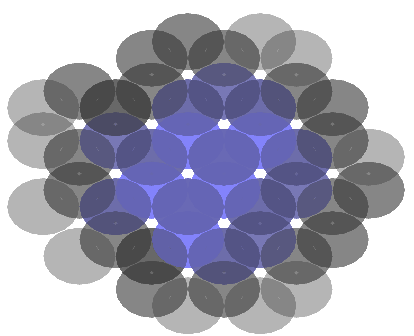Here I used a numerical approach roughly equivalent to the analytic approach in Poutnik's answer. The procedure is to generate the smallest enclosing sphere containing within its radius 100 hexagonally close-packed beads, and then determiningdetermine the number of beads in a second smaller concentric enclosing sphere. If r=1 is the radius of a bead, R=5.074 is the radius of the sphere enclosing 100 close-packed beads. Then ana concentric enclosing sphere that is smaller by r/2 contains 69 beads, one that is smaller by r contains 52 beads, and one that is smaller by 2r contains 24 beads. Note that in order to containplace exactly 100 beads into a perfect sphere, the arrangement of beads is not symmetrical.
There are alternate (and better) ways of distinguishing between interior and surface beads, for instance to count the number of nearest neighbourscontacts. In an hcp arrangement this is a maximum of 12, with surface beads having less. Using such counting reveals that only 25 beads are not on the surface and have all 12make the max possible near contacts. Like the previous estimation method, thiscontact counting one does not check whether there are gaps etc. These clearly exist as shown in the following (interior beads are colored blue, surface ones black):
Since N=100 is not very big, some of the approximations used in the analytic approaches proposed in other answers are bound to fail. Consider my answer: the number of interior beads predicted by a numerical method is nearly the same as the number of surface beads according to the large N approximation. In fact the number of surface beads is more nearly that expected for a cube (see Poutnik's answer) rather than an ideal (large N) sphere. This problem was made to be solved by experiment (numerical or otherwise).


